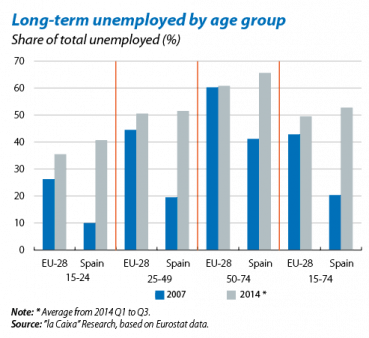On long-term unemployment in Spain
The labour market provided some good news in 2014: the number of employees increased by 433,900, a figure that ended up exceeding the expectations of most analysts. The 2.0 pps drop in the unemployment rate also came as a pleasant surprise. The trends in the labour market are therefore encouraging but the aftermath of the intense recession over the last few years is still being felt.
The clearest example of this is the unemployment rate, which was still unacceptably high at 23.7% in 2014 Q4. Another consequence of this abnormal situation is the exceptional long-term unemployment rate, reaching 14.6% the same quarter. The actual share of long-term unemployed (LTU) out of the total unemployed is not particularly high in Spain, namely 53.4% in Q3 which is a similar rate to that of the EU-28 at 49.9% (according to Eurostat). However, given that the number of unemployed is very high in absolute terms, so is the number of long-term unemployed.
The first consequence of the rise in LTU is a large group of unemployed people who are not covered by the safety net for unemployment. This is designed to lessen the impact of temporary unemployment on a person's income while not discouraging people from looking for a new job. Under other economic conditions, such as those existing between 2002 and 2007, the average length of unemployment was around 12 months.1 Given this situation, with coverage lasting two and a half years if we take into account both the contributory unemployment benefit and the non-contributory unemployment allowance, it was enough to alleviate the situation in the vast majority of cases. In fact, both the duration and the size of the safety net existing in Spain are slightly higher, on average, than those of the EU-28 countries as a whole.2
However, the exceptional severity and duration of the crisis over the last few years have meant that, in many cases, this safety net has not been enough. In fact, in 2014 Q4 the average duration of unemployment had increased to 23 months. We should note that, on 19 December 2014, the government passed the Employment Activation Scheme, granting a subsidy for six months to LTU who had already used up all their entitlement to unemployment protection provided they carry out the activation actions proposed by the employment services.
Another consequence of LTU, less evident but with important economic and personal repercussions, is the decapitalisation involved both for the person him or herself and for the economy as a whole. The most manifest and worrying example is that someone becomes increasingly less likely to find another job over time. For example, according to estimates by De la Rica and Anghel (2014),3 all things being equal, a person who has been unemployed for less than two years has a 50% greater chance of finding a job than a person who has been unemployed for more than two years.
Although the underlying trends in the labour market are encouraging, both the high unemployment rate and especially the large number of long-term unemployed mean that the fight against unemployment must continue.
1. The duration of unemployment is an approximate calculation based
on the periods of time spent looking for employment, provided by the Spanish Statistics Institute (INE).
2. See «Unemployment Benefits in EU Member States», Employment, Social Affairs and Inclusion, July 2013 (European Commission).
3. See De la Rica, S. and Anghel, B. (2014), «Los parados de larga duración en España en la crisis actual», Documento de Trabajo 185/2014, Laboratorio de Alternativas.




